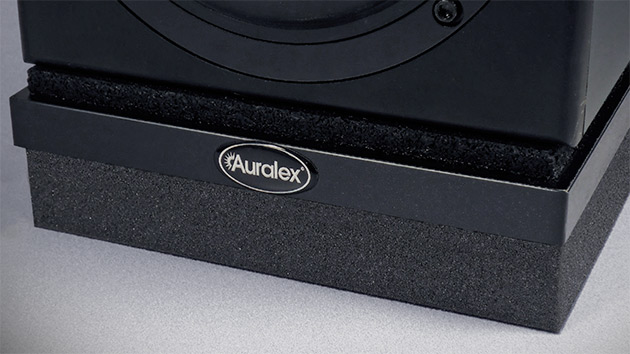A No-Brainer Approach to More Accurate Sound Reproduction
It’s been over 10 years since I’ve touched a fader on a big SSL mixing console or turned a knob on a Neve EQ. Most of my billable work is performed in my home studio, as is the case with many post-production professionals these days. Since my clients and I are now performing critical viewing and listening tasks in my studio, it is important that what they hear and see will translate to the real world. Like most of us working from home, I am limited by budget and space, so owning my own screening theater with a color-accurate projector and Dolby-certified surround monitoring is just not going to happen. For me, every piece of equipment I buy requires that I ask myself, “Will this piece of gear generate money for me?” Enter Auralex.
I recently had the opportunity to test Auralex’s ProPAD speaker isolators. The immediate improvement they provide in the stereo image, as well as the lows and mids, is staggering. Frankly, I’m ashamed that I haven’t used them earlier because they are so simple, inexpensive and incredibly effective. If you’re not familiar with them, ProPADs are an upgraded version of their popular MoPADs, vibration-dampening pads that slide between your speakers and the furniture on which your speakers sit. ProPADs stop unwanted vibrations from transferring between the speakers and the furniture, which colors the overall sound. ProPADs ($149/pair) are designed for smaller, near-field reference monitors with up to 8-inch woofers, while ProPAD XLs ($249/pair) are designed for larger speakers, like those with twin woofer designs. Each ProPAD sandwiches three layers of vibration-dampening material: Auralex Platfoam (used in MoPADs), ¾” MDF wrapped in Melamine, and a thick layer of ISO-Plate made from 100% recycled rubber. The three materials work well to isolate your speakers from their surroundings, which translates to a more accurate monitoring environment.
Upon “installing” the ProPADs, I instantly heard a more clearly defined low end. On the composer’s score, the bass notes, from about 400 Hz and lower, transformed from muddy and “woofy” to tight and punchy. I also found that the midrange frequencies, around 2 kHz, were more present, making the dialogue more defined in the LtRt conversion of a 5.1 mix. In one section, the composer’s horn melody, which had previously competed for space in the mix with the dialogue, became clear as a bell, as did the dialogue. Percussive sounds suddenly jumped out, where before they sat deep in the mix. Almost as impressive was the increased definition I heard in the stereo separation. Reverbs and sound effects took on a new life as they moved clearly between speakers.
The ProPADs were so effective in my home studio, I decided to try the ProPAD XL in my living room to isolate my home stereo speakers from the floor. As soon as I dropped the needle on The Beatles' Abbey Road, I knew I couldn’t live without the ProPAD XLs. Instead of hearing the house vibrate from the lows dispensed from the woofer, everything sounded balanced, with low-end and high-end complementing each other instead of fighting each other. And, by using the ProPAD XL’s included angled foam, I was able to slightly tilt the stereo speakers up, as well as decouple them from the floor, which immediately opened up the highs and the stereo image. In an acoustically untreated room, my stereo has never sounded more true.
Auralex’s ProPAD and ProPAD XL makes me feel like I am finally hearing my reference monitors and stereo speakers the way the manufacturer intended. The Auralex ProPADs are the most valuable change I’ve made to improve the accuracy of my listening environment since I did basic acoustic treatments to tame the immediate reflections in my room. The ProPADs are not going to take the place of proper acoustic treatment for a studio or listening room, nor will they make bad speakers sound good. But for the money, I can’t think of an easier, more effective improvement for any environment where critical listening is the primary concern. Whether you’re mixing for picture, making records or just getting back into vinyl, Auralex’s ProPADs are a no-brainer approach to instantly provide more accurate sound reproduction from your speakers and help ensure that your mixes will translate to the rest of the world.
Nathan Adams is a freelance post supervisor and owner of Cinematomic. In addition to his tenure consulting on equipment for various resellers, Nathan Adams has worked as an engineer and post-production specialist for almost two decades. Cinematomic is a post-production company in Los Angeles specializing in independent feature films, documentaries, television and web content.










